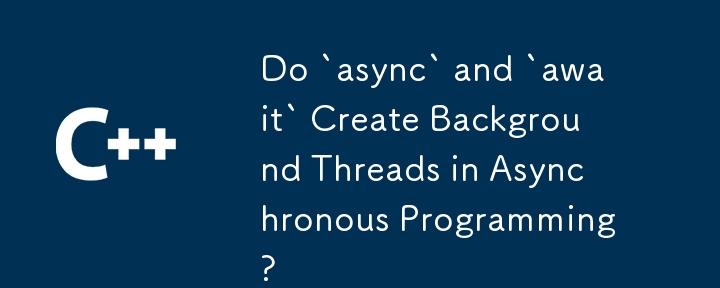

Async and Await: Unraveling Asynchronous Programming
Modern programming relies heavily on asynchronous operations using async and await. While improving code readability, these keywords introduce complexities that often require further explanation. A common misconception is that async and await create new background threads for lengthy processes.
The reality is more nuanced. async and await manage asynchronous tasks, but they don't directly spawn threads. Instead, they utilize a different approach. The compiler generates a state machine behind the scenes when it encounters an async method.
Let's illustrate with an example:
private async void button1_Click(object sender, EventArgs e)
{
Task<int> access = DoSomethingAsync();
// Other independent tasks here
int a = 1; // Immediately accessible
// Wait for the result of DoSomethingAsync()
int x = await access;
}
async Task<int> DoSomethingAsync()
{
// Does this run on a background thread?
System.Threading.Thread.Sleep(5000);
return 1;
}Here, await instructs the compiler to pause button1_Click until DoSomethingAsync finishes. Execution resumes once the task completes, allowing immediate access to a.
Crucially, DoSomethingAsync doesn't run on a dedicated background thread. The compiler's state machine schedules it asynchronously on a thread pool thread. This means the execution environment of DoSomethingAsync isn't predetermined; it can run on any available thread pool thread.
Mastering the interaction between async and await is vital for creating efficient, scalable asynchronous code. This mechanism allows long-running operations without blocking the main thread, leading to a more responsive and fluid user experience.
The above is the detailed content of Do `async` and `await` Create Background Threads in Asynchronous Programming?. For more information, please follow other related articles on the PHP Chinese website!
 How to connect broadband to server
How to connect broadband to server
 HTTP 503 error solution
HTTP 503 error solution
 How to skip connecting to the Internet after booting up Windows 11
How to skip connecting to the Internet after booting up Windows 11
 How to turn on Word safe mode
How to turn on Word safe mode
 The role of html title tag
The role of html title tag
 jquery animate
jquery animate
 kb4012212 What to do if the update fails
kb4012212 What to do if the update fails
 What to do if the embedded image is not displayed completely
What to do if the embedded image is not displayed completely
 How to export word from powerdesigner
How to export word from powerdesigner




